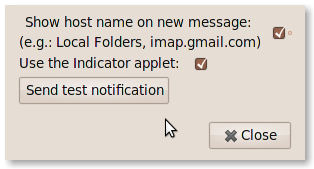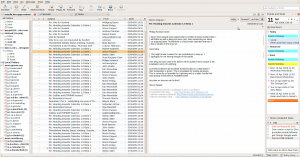Indicator Applet & libnotify support for Thunderbird
This looks great!I’ve never really got on with Gnome‘s Evolution (the default mail client in Ubuntu) and so always install Thunderbird, Lightning and other great extensions for the Mozilla family of products on my Ubuntu desktops and laptops. Since the new notification tool (9.04?) and then the Indicator Applet (9.10) were introduced however, Thunderbird hasn’t been able to avail itself of these useful tools. Until now.
Ruben Verweij has created a small Thunderbird extension that seems to fix this limitation. Simply follow the very clear and easy instructions on his blog post to create the .xpi package and then install it in the usual manner. I had to install the Ubuntu package libnotify-bin to get the notifications working but that was easy: sudo apt-get install libnotify-bin.
You can then turn off Thunderbird’s internal notification tool as shown here. This stops the old-fashioned opaque pop ups that usually appear in the bottom right of the screen.
As Ruben is clear to point out this is still experimental so all the usual rules apply and YMMV.
It has worked for me so far and was easy to install and set-up. In fact, I only just noticed, whilst I was writing this, that there is a “preferences” dialogue for the extension. Short and sweet:Thanks Ruben, this is a great addition.
How to run Firefox 3.5 on Ubuntu 9.04 Jaunty Jackalope
Mozilla Firefox 3.5 was released yesterday. It isn’t (at the time of writing this) available for install through the repos on Ubuntu Jaunty. I guess it will be backported at some stage but should you want to play about with it, here is how I did it so as not to (hopefully) break anything else… [Note: you should probably back up your profile directory before going any further. Something like this should do it: cp -a ~/.mozilla ~/firefox-3.0-backup]
I downloaded the Linux tarball and unpacked it. I moved this directory (called firefox) to my local bin dir:
mv firefox ~/bin/firefox-3.5
This command assumes you are in the same directory as the tarball you just extracted and have a local bin directory. If not just do mkdir ~/bin first.
Then I started the current Firefox Profile Manager and created a new profile just for 3.5 to test (I didn’t want any conflicts or updates to my existing firefox 3 add-ons). To check that you are using the right path for the existing installed Firefox you can do a command like which -a firefox which will give you the full path to any firefox executables on your system and in your path.:
/usr/bin/firefox -no-remote -ProfileManager
Follow the Profile Manager dialogues to create a new profile – I called mine 3.5 amazingly. Exit the profile manager (don’t start firefox or else you’ll end up with the existing firefox also using the 3.5 profile).
Now you can run the 3.5 version of Firefox by typing the following command:
~/bin/firefox-3.5/firefox -no-remote -P 3.5
The -no-remote switch ensures that we start a clean instance of FF from these commands. If you already have an instance of FF running and you do not use this switch, you’ll get another window tied to the same, already running, firefox process. This also affects trying to start firefox remotely over X as I discovered quite some time ago.
I have since created a launcher on the top panel to start FF3.5.
It seems to work OK and feels incredibly fast at loading pages, but trying to run anything that needs flash causes it to die horribly.
So although this isn’t perfect, it was a reasonably safe way to test and just try it out. YMMV of course and I really think we’d all probably be better just waiting for one of the MOTU “Gods” to deliver a 3.5 backport for Jaunty. 🙂
Songbird 1.2 Released
My favourite music player has just been updated and version 1.2 released.
I picked up the story from The H where they’ve done a great job of describing most of the new features in a single paragraph.
One of the biggest new features is the ability to automatically organise library files across multiple folders based on track metadata, such as artist and album information. In addition to several performance improvements to features like search, Songbird 1.2 now supports 2-way syncing with iTunes, which is especially useful for users who purchase songs in the iTunes Music Store. Songs added to Songbird can also be synced back into iTunes for syncing with iPods and iPhones. Last.fm support has been included in Songbird for some time now, however, users can now access even more artist, track, album and tag information. A new 10-band equalizer has been added to Songbird to let audiophiles tweak the frequency response of audio playback.
With the ever expanding feature set and the superb extensibility thanks to their Mozilla platform pedigree we have a really good alternative to the “other” much touted music player based on Mono. I know which one I prefer.
Songbird, incidentally, was the only music player I found on Ubuntu that would sync with my iPod Nano 4th Gen. And that was the previous release of Songbird too. With iTunes synchronisation I think I have just found the last piece of the puzzle to get my wife off Windows once and for all.
Thanks to all the community and developers behind Songbird. I can’t wait to get this new release installed and give it a work out.
Jaunty, Thunderbird 3 and Lightning
First a sort of apology I guess. Things have been really busy recently so I am not finding as much time to blog as I would really like.
Having said that, I took the opportunity yesterday to migrate my main desktop PC from Ubuntu 8.10 Intrepid to the soon-to-be-released 9.04 Jaunty Jakalope and I also upgraded my email client from Thunderbird 2 to a recent nightly build of the nearly-ready Thunderbird 3 release along with the excellent calendar extension Lightning.
Because of the way I partitioned the disk originally, this was a fairly trivial exercise but I thought some might find this information useful.
I already had a Jaunty build installed on one of the three 15GB partitions I created for Operating Systems (see here for how I originally partitioned the drive). The only thing I needed to do was to alter my fstab to add a mount point for the /home partition.
Ubuntu uses a UUID descriptor for disks as opposed to the more easily understandable /dev/sda[x] nomenclature. So how do you find out the UUID of a partition?
sudo vol_id /dev/sda8 will return various useful bits of info as in my case here:
ID_FS_USAGE=filesystem
ID_FS_TYPE=xfs
ID_FS_VERSION=
ID_FS_UUID=5a2ecbcf-ab2d-4696-ae87-a3a15c559f70
ID_FS_UUID_ENC=5a2ecbcf-ab2d-4696-ae87-a3a15c559f70
ID_FS_LABEL=
ID_FS_LABEL_ENC=
sda8 is the large (250GB) xfs partition I created for /home. My Intrepid installation lives in /dev/sda5 with a separate mount for /home and /boot. So When I installed Jaunty a few weeks ago to start testing it I installed that in /dev/sda6 and let it have it’s own /home directory.
I was happy with Jaunty’s stability so I decided to move across. After backing up my home directory first (using rdiff-backup) I then only needed to add a couple of lines to the /etc/fstab file of the Jaunty build.
# /dev/sda8
UUID=5a2ecbcf-ab2d-4696-ae87-a3a15c559f70 /home xfs relatime 0 2
Before I rebooted, I ran a sudo mount -a command which mounts everything according to fstab and checked that /home was mounted to /dev/sda8 as I wanted. I logged in and checked the home dir was as I had left it. I then unmounted /home and removed my “alord” directory from the Jaunty partition after copying any files I needed of course. This step isn’t really necessary but I like to clean up after myself 😉
Finally I swapped the default start-up item in the /boot/grub/menu.lst to be my Jaunty build and rebooted to check everything works. It did.
Installing Thunderbird 3 (Shredder) was simple. I downloaded the nightly tarball from here along with the nightly Lightning build from here. The Thunderbird tarball is already compiled so I simple extracted into my home bin directory and set up a menu item for it. Upon starting TB3 it picked up my existing .thunderbird directory and all my accounts and mail settings. It did rightly so complain that the lightning extension was not the right version and disabled it. I uninstalled the old 0.9 version and then installed the new lightning.xpi nightly I had downloaded. After restarting shredder all my calendars were loaded as I would have expected.
The reason for me using this potentially fragile version of Thunderbird is because there is an annoying bug in the Lightning 0.9 extension when working with the Cosmo Calendar server. The bug has been fixed, but only in the recent versions which are tied to TB3 and that probably won’t get backported. The Mozilla calendar folks are having a hard time right now – the Sunbird standalone calendar app is not going to be maintained or developed further by the calendar developers as they don’t have the bandwidth to support that and Lightning. TB 3 has moved onto the newer 1.9 Gecko engine and hence the new Lightning not working with TB2 which is built on the older 1.8 Gecko.
The good news is that Shredder and Lightning seem to be fine for me (Disclaimer: Of course YMMV). TB3 uses the tabbed pane concept so my calendars/tasks and mails now live on tabs hat are easy to switch between. The overall UI of TB3 has been extensively reworked and there are some great new features some of which are covered in this article.
Here’s a screenshot of Shredder where you can see some of the UI changes etc.
Did Microsoft make Firefox?
This post by Matt Assay discussing how we got to a competitive browser market got me thinking. (Dangerous I know, but bear with me.)
… I suppose the truly intriguing thing is not that we have a competitive market for Web browsers again, but how it happened. Baker told me recently that Firefox is “an anomaly” because it managed to beat back overwhelming Microsoft market share. Can we do it again?
What was the tipping point when Microsoft’s Internet Explorer team finally had to start paying attention to Mozilla’s Firefox browser? And when did Google decide that it couldn’t subsist on Firefox’s roadmap and instead had to forge its own browser, Chrome?
 My own take on this is it was all Microsoft’s own doing. Think about it. Their browser, Internet Explorer [and more specifically IE6], was locked into the operating system that ran an almost every PC sold. So for Mozilla’s Firefox browser to take more than a 20% market share is pretty staggering. If you use Windows (as certainly a few years ago almost everyone did) you already have a browser on that Windows PC so why go and download another one? It isn’t quite the same for OpenOffice.org or Gimp for example. You are having to make a decision about acquiring an Office Application Suite or an Image Editor; whether you pay for commercial code or use FOSS is your choice. But with the browser, you already have one.
My own take on this is it was all Microsoft’s own doing. Think about it. Their browser, Internet Explorer [and more specifically IE6], was locked into the operating system that ran an almost every PC sold. So for Mozilla’s Firefox browser to take more than a 20% market share is pretty staggering. If you use Windows (as certainly a few years ago almost everyone did) you already have a browser on that Windows PC so why go and download another one? It isn’t quite the same for OpenOffice.org or Gimp for example. You are having to make a decision about acquiring an Office Application Suite or an Image Editor; whether you pay for commercial code or use FOSS is your choice. But with the browser, you already have one.
My conclusion to Matt’s question is that it comes down to just how bad IE6 really was. If it had been a half decent browser with acceptable support for the standards it was supposed to support then I don’t think Firefox, and possibly the entire FOSS ecosystem, would be as strong as it is today.
Presumably Microsoft could have patched and updated IE6 during the course of it’s life but they chose not to, and instead stuck to delivering a half-baked, non-compliant browser full of leaks and security holes and proprietary features that lead many unfortunate souls to build sites that only worked with Microsoft’s browser.
I think that it was the web development community that started this movement. Being professionally involved in helping Graphic Designers make websites work across browsers, I know just how BAD IE6 really is when it comes to supporting standards. If it hadn’t been so terrible, or even got fixed, I don’t think the web developer community would have started using Firefox in the numbers that they did and then espousing it’s virtues with quite the same level of gusto.
Of course, as well as being a decent browser, there were many new and innovative ideas and features in Firefox, a huge extension and plug-in library and cross platform support too. But as “most” users of a browser are simply surfing, then if IE wasn’t such a pile of steaming poo in the first place I don’t think many consumers would have been inclined to change at all.
What do you think?
Migrating from Windows
The last Windows computer in our house is very shortly going to be history 🙂
I have been threatening my wife’s PC for quite some time now, but there has been no real motivation to move until today… Our bank called and told her a credit card has been fraudulently used in the last few days. Fortunately they appear to have correctly and swiftly identified the misuse and are dealing with the problem.
However, this experience has obviously caused my beloved (Helen) to start wondering how her details were captured in the first place. She is pretty scrupulous with the shredder, and this particular card is almost only ever used for on-line transactions; so her PC was a possible, if not likely, route for the thieves. The ClamWin AV scan threw up a few nasty sounding files, including some IE.IFrame trojan thing, although they had all been quarantined already. But the fact that Windows is so vulnerable to attack and subsequent compromise when compared to Linux, this saga has just tipped the scales. We now have a good reason to start the final migration of the Lord household.
This evening, I have installed Thunderbird on Helen’s Windows PC and imported everything from her Outlook email client. The import was basically flawless and after changing a few settings she’s now up and running with TB. (Interestingly, her first few comments were very positive: “This looks nice”, “It’s much faster”, “I like the address book layout” and so forth.) I added Lightning and connected her up to our caldav Calendar Server (Cosmo) which is an added bonus for Helen. We all use this for work, family and personal scheduling and Helen had been limited to using web access (simply because Outlook doesn’t support the Caldav standard) which is not the optimum interface to this calendar.
Helen was already using Firefox most of the time but now I’ve asked her to stop using IE altogether.
Helen also has OpenOfice.org (OOo) installed already but has not been using it much as the Windows defaults are [were] set for MSO 2003. This will probably be the area where there will be some new learning as she stops using MSO and starts using OOo but it isn’t that painful to be frank.
I think within a month, I will install Ubuntu 8.10 as a dual boot for a short period just in case she finds there are things that don’t work and then we’ll turn off the malware-that-pretends-to-be-an-OS Windows within a few weeks from then.
She does use iTunes for her work and pleasure so I am thinking we’ll need to have a VM (VirtualBox) running her copy of XP to support that, unless someone would like to offer advice on alternatives. She runs music therapy classes and her material is ripped onto her iPod using Apple’s lossless codec IIRC that iTunes seems to default to. Never having used it myself, nor do I own an iPod I am not the best source of advice on this one so if anyone can help here I’d be grateful.
I can’t think there is much else that will bite us though; she doesn’t have any other proprietary apps I can see that are going to prove troublesome to replace.
One thing that is really important in this story is this ability to run the main applications: Firefox, Thunderbird and OpenOffice.org, on both Windows and Linux platforms. It will make the transition, for a non-technical user, much less painful than having to switch wholesale over to new apps and a new OS all at the same time. Thanks Mozilla and OOo.
As we go through this migration I’ll write a little more (I might even ask Helen to document her experiences and thoughts). Hopefully it will help others doing, or wanting to do, the same thing.





